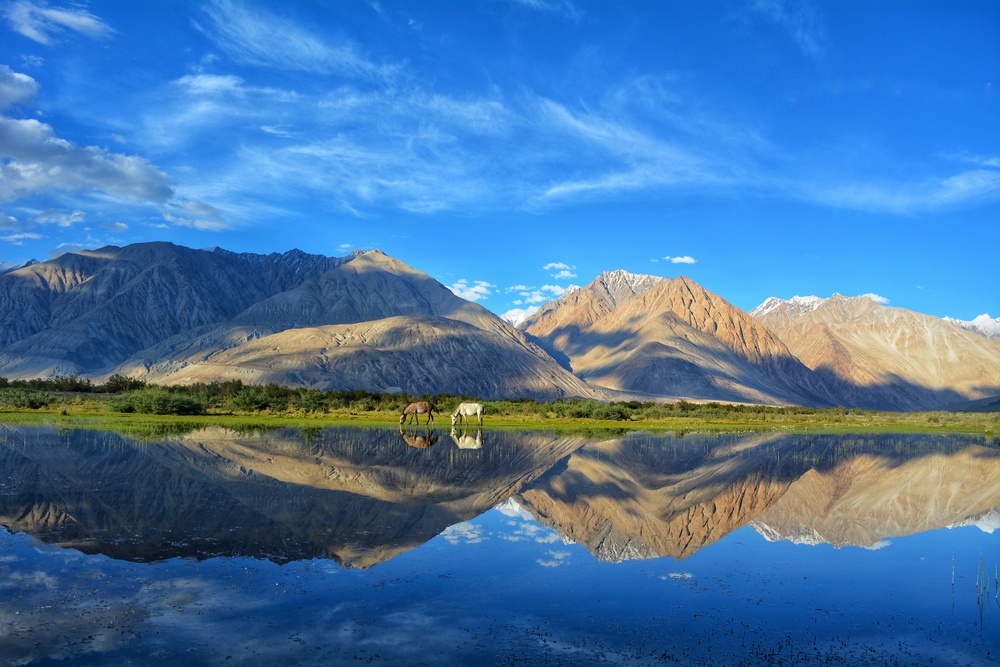Ladakh Tourism: Explore the Land of High Passes and Monasteries
Ladakh, popularly known as the ‘Land of High Passes’, is a destination that has fascinated travellers for decades. Nestled in the northernmost region of India, Ladakh tourism offers a perfect blend of raw natural beauty, ancient monasteries, unique culture, and thrilling adventure activities. Whether you are a nature lover, spiritual seeker, or an adventure enthusiast, Ladakh promises an experience unlike any other place in India.
A Land of Surreal Landscapes
Ladakh tourism is defined by its dramatic landscapes. The region is surrounded by the mighty Karakoram and Himalayan ranges, offering breathtaking views of snow-capped peaks, vast barren valleys, turquoise lakes, and rugged terrains. The drive from Manali to Leh is one of the most scenic journeys in the world, crossing high mountain passes like Rohtang La and Tanglang La.
Pangong Lake is one of the highlights of Ladakh tourism. This stunning lake, located at an altitude of 14,270 feet, changes colour from blue to green to grey depending on the sunlight and sky conditions. Another unmissable spot is Tso Moriri Lake, a tranquil high-altitude lake surrounded by snow-clad mountains, offering absolute peace to visitors.
Monasteries: The Spiritual Heart of Ladakh
No Ladakh tourism experience is complete without visiting its ancient monasteries. Ladakh is dotted with Buddhist gompas, each radiating spiritual serenity and showcasing the rich heritage of Tibetan Buddhism. Hemis Monastery, the largest in Ladakh, is famous for its annual Hemis festival dedicated to Guru Padmasambhava. Thiksey Monastery, often compared to the Potala Palace of Lhasa, is known for its massive Maitreya Buddha statue and panoramic views of the Indus Valley.
Diskit Monastery in Nubra Valley is another gem. It is the oldest and largest monastery in Nubra and houses a 106-feet statue of Maitreya Buddha overlooking the valley. Alchi Monastery, built in the 10th century, is renowned for its ancient murals and intricate woodwork. Each monastery not only offers spiritual solace but also a glimpse into the culture, rituals, and artistic traditions of Ladakh.
Adventure Activities in Ladakh
For thrill seekers, Ladakh tourism is a paradise. The region offers numerous adventure activities that challenge your endurance and reward you with unmatched memories. Trekking is the most popular adventure in Ladakh. The Markha Valley trek, Chadar trek over the frozen Zanskar river, and Stok Kangri trek are some of the top treks that attract adventurers from across the globe.
Motorbiking through Ladakh is a dream come true for bikers. Riding through the world’s highest motorable passes like Khardung La (18,380 feet) and Chang La (17,586 feet) offers an adrenaline rush like no other. Mountain biking, river rafting in Zanskar, camping under star-lit skies, and camel safaris in Nubra Valley’s sand dunes are also gaining popularity in Ladakh tourism.
Unique Culture and Festivals
Ladakh tourism is not just about nature and adventure; it is also about experiencing its rich culture. The people of Ladakh, primarily of Tibetan descent, follow Tibetan Buddhism and live a life deeply connected to nature and spirituality. Their hospitality is warm and genuine, making travellers feel at home even in the remotest villages.
Festivals in Ladakh are vibrant, colourful, and deeply rooted in Buddhist traditions. The Hemis festival, Ladakh Festival, and Losar (Tibetan New Year) are celebrated with traditional music, masked dances, and rituals that attract tourists keen on cultural immersion.
Best Time to Visit Ladakh
The ideal time to explore Ladakh tourism is from May to September, when the weather is pleasant and roads remain open. During this time, the temperature ranges from 5°C to 25°C, making it perfect for sightseeing and adventure activities. In winter (October to March), Ladakh transforms into a white wonderland. Though extreme cold makes travel challenging, it is the best time for the famous Chadar trek and to witness the frozen beauty of Ladakh.
Tips for Travelling to Ladakh
- Acclimatise well: Due to high altitude, AMS (Acute Mountain Sickness) is common. Take rest on arrival for a day or two to adjust to the altitude.
- Carry cash: ATMs are only available in Leh. Remote regions often do not have card facilities.
- Travel responsibly: Ladakh is ecologically sensitive. Avoid plastic, respect local customs, and leave no litter behind.
- Inner line permits: Some areas require permits for tourists, including Nubra Valley, Pangong Lake, and Tso Moriri. Arrange them in advance.
Conclusion
Ladakh tourism is an unforgettable journey that awakens your soul with its majestic mountains, pristine lakes, ancient monasteries, and the warmth of its people. It is a place where every traveller finds a new perspective on life. Whether you are riding through its high passes, meditating in a monastery, or gazing at the Milky Way in its clear skies, Ladakh promises memories that will remain etched in your heart forever. Plan your Ladakh tour soon and explore this magical land that stands timeless and majestic in the lap of the Himalayas.



Leave a Reply
Want to join the discussion?Feel free to contribute!